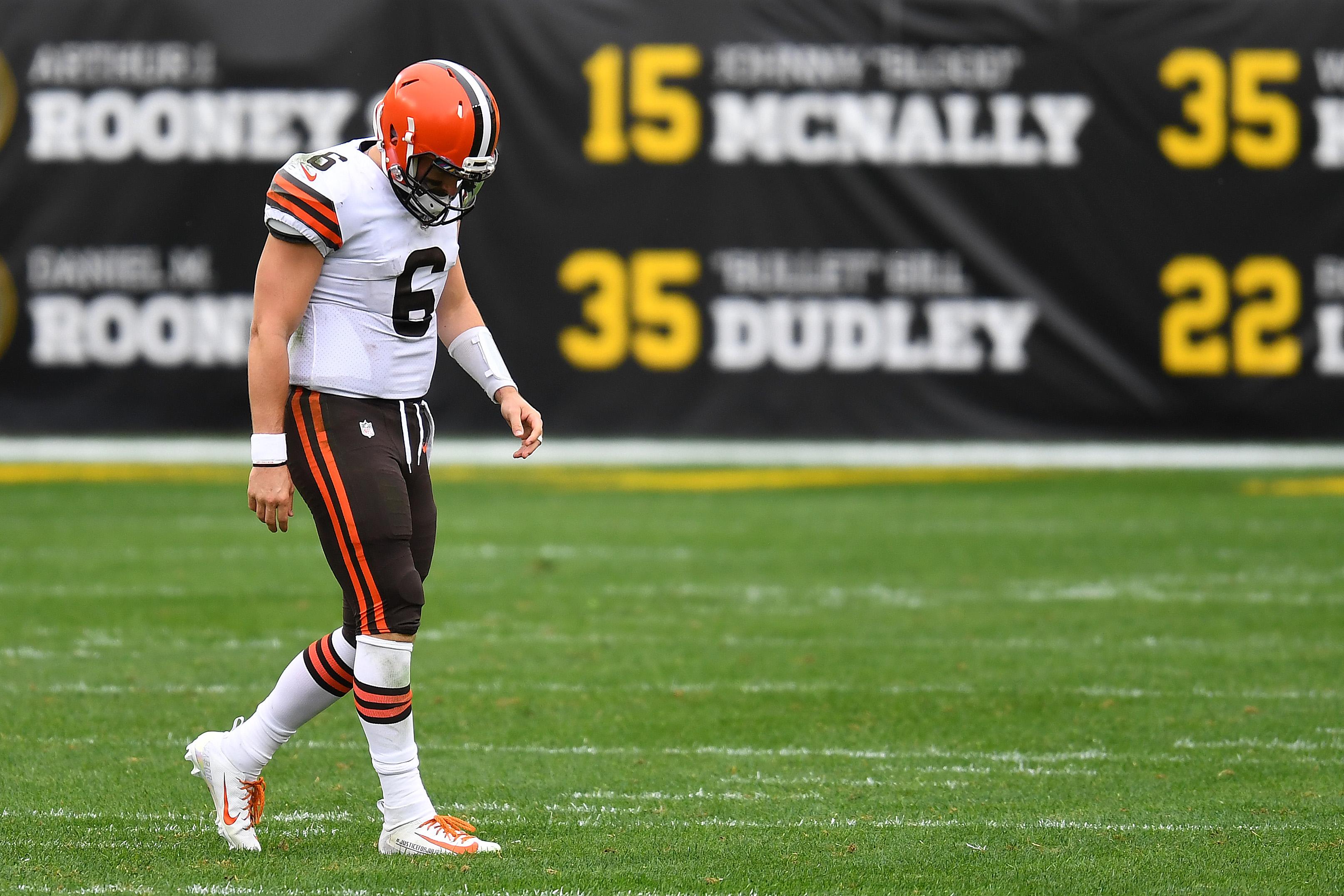
There currently seems to be a Baker Mayfield–sized gap separating the Browns from the top of the AFC North. Cleveland benched its quarterback in the third quarter of a 38-7 blowout loss to the Steelers on Sunday, but the benching isn’t really the problem: Coach Kevin Stefanski told reporters after the game that his decision to yank Mayfield was rooted in protecting the signal-caller. Mayfield was limited in practice this week with a rib injury that he sustained late in last week’s win against the Colts, and he’d already been sacked four times before he got pulled.
The issue isn’t even really how Mayfield looked when he was in the game, though his performance certainly wasn’t pretty. He completed 10 of 18 passes for 119 yards, one touchdown, and two interceptions, and posted a 54.9 QB rating.
Instead, the problem is that Mayfield exacerbates issues across the rest of the team—and that has created a chasm between the Browns and the teams they’re chasing in the division.
Mayfield wasn’t good on Sunday; that’s no secret. But it didn’t help that he was standing behind Cleveland’s offensive line. Despite the unit’s talented members—and the fact that the group entered the week first in Football Outsiders’ adjusted line yards—it put up hardly any fight against the Steelers’ powerful front. In addition to four sacks, Pittsburgh recorded seven total QB hits, resulting in a ridiculous amount of pressure.
That ineptitude trickled into the rushing game, which was already missing starting running back Nick Chubb. Backup Kareem Hunt managed 40 yards on 13 carries (3.1 yards per attempt), and the Browns posted just 75 rushing yards total (3.4 yards per carry).
The Steelers boast one of the best front sevens in the NFL. Pittsburgh entered the contest leading the league in QB hurries per dropback (20 percent), QB pressures (70), pressure rate (41.2 percent), and was tied for first in sacks (20). Stefanski credited Mayfield for attempting to play through his ailment and the bevy of hits, but without a rushing attack or much protection, there was only so much he could do. “He’s a very, very tough player, and I know he wants to fight,” Stefanski said of Mayfield. “But it’s a long season. We’ve got a game next week and I didn’t feel like it was the right thing to put him back out there.”
The offense has been a stop-start unit so far this season, featuring some excellent games (dropping 49 points against the Cowboys and putting up 32-plus points in three other contests) and a couple ho-hum showings. Mayfield entered the week ninth in the league in average depth of target (8.8) and eighth in QBR. However, his execution hasn’t allowed the Browns’ offense to reach its highest potential.
Mayfield has yet to throw for more than 250 yards in a single game this year, and his 6.4 yards per attempt was tied for 26th among qualified passers entering the game. Some of that inconsistency undoubtedly stems from the fact that this is Mayfield’s first season working with Stefanski, but Browns general manager Andrew Berry intentionally constructed this roster so that the quarterback would be the missing piece of the puzzle to the franchise’s success. Unfortunately, Mayfield hasn’t been that.
There’s still time for Mayfield to develop into an upper-tier starting quarterback. And the Browns are 4-2, so Mayfield not playing at an elite level hasn’t been a complete detriment. But it has highlighted some of Cleveland’s shortcomings—most notably, that this team is still staring up at the Steelers and Ravens within the AFC North.
Since 2015, the Browns are 4-17-1 combined against Baltimore and Pittsburgh. The best barometer for how good this Cleveland team is its performances against those two rivals. The Browns have lost matchups to both this year, by a combined score of 76-13. Stefanski avoided a postgame question directly comparing the Browns to the Steelers and how disappointing Sunday’s result might be. Instead, he bemoaned his own play-calling and praised Pittsburgh for its dominant showing.
“Bottom line, [we] got beat. Credit to them,” Stefanski said. “[We] didn’t do anything right. Offensively, couldn’t sustain drives, couldn’t get a first down on third or fourth down. But again, credit to them.”
Mayfield’s turnovers didn’t help the Browns’ chances on Sunday. His first pick was returned for a touchdown in the first quarter, and his second gave Pittsburgh a short field. And he barely got Odell Beckham Jr. (two catches, 25 yards on four targets) and Jarvis Landry (three catches for 40 yards on five targets) involved in the passing game, much to Beckham’s frustration.
Despite Pittsburgh’s 38 points, Cleveland’s defense held its own, forcing four punts and limiting Pittsburgh’s passing attack to 148 yards (7.3 yards per attempt). That’s perhaps the lone moral victory to be taken away from a result like Sunday’s, where the divide between the Browns and their rivals remains so evident. Mayfield playing at a higher level could surely help close it. But whether that’s possible or not remains to be seen.
“The good thing is, we play both those teams again, and we can learn to get better,” Mayfield said. “So, it’s on to the Bengals for now. We have to continue to get better.”